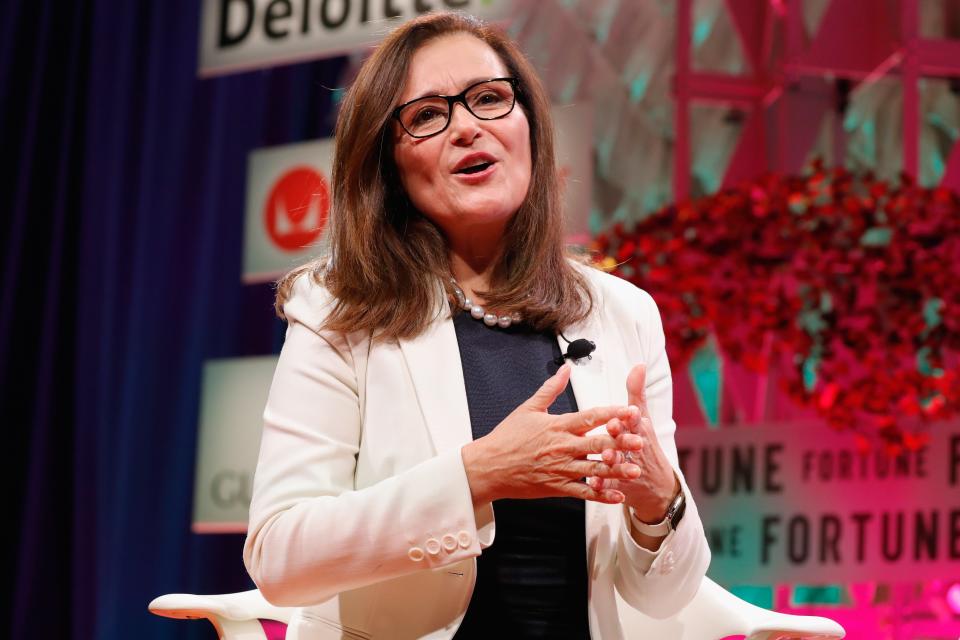Former PG&E CEO Geisha Williams on the lack of Latina executives in top companies: 'It's got to change'
Five years ago Geisha Williams became the first Latina CEO of a Fortune 500 company. There has only been one other since.
Hispanic and Latina women make up just 1.6% of senior executives in the nation’s largest companies, according to a USA TODAY analysis of the S&P 100.
They lag behind nearly all other major demographic groups in the executive ranks – white men and white women, Black men and women, even Hispanic and Latino men – but are disproportionately represented in lower-paying, low-mobility jobs, the analysis shows.
According to the Latino Corporate Directors Association, Latinas hold fewer seats on the boards of directors of Fortune 500 companies than any major gender or ethnic group, just 1%.
“There is still bias out there," said Williams, the daughter of Cuban political refugees. "It’s the only thing that can explain why there aren’t more women CEOs period, whether they are Latina or not. And I think that’s something you just have to call out.”

After graduating from the University of Miami with an engineering degree, Williams spotted an ad for a paid summer internship at Florida Light & Power. She worked her way up from a marketing service representative to vice president of power systems. She once guided the company through seven hurricanes in 15 months.
Why so few Hispanic women make it to the top: Only two Latinas have been CEO of a Fortune 500 company
Recruited by PG&E, she moved to California. In 2017, she was named CEO, just months before the utility’s power lines sparked deadly wildfires. She stepped down less than two years later as the company prepared for bankruptcy.
In an interview, Williams discussed the barriers Latina executives face in corporate America. Responses have been edited for length and clarity.
Why she’s fed up with the lack of Latina executives
I started getting all these congratulatory notes, with people talking about me being the first, and I couldn’t believe it. I was really happy for me but you’ve got to be kidding me. How can I possibly be the first one? I asked my team to vet it to make sure that was the case and, sure enough, they came back and said, “yeah.”
Why there are so few Latina board members
I’m on three corporate boards, two are private equity and one is a public board in Europe. But I am on no large public boards in the United States.
I’ve spoken to many headhunters about it. They all think I’m an incredible candidate with a tremendous background in leadership, board governance, energy, regulatory, crisis management, people, labor, you name it.
What they’ve said to me is: “We just haven’t found the right position for you yet. You have to be patient. It’s going to happen.” I’ve been out of the workforce for five years and it hasn’t happened.
Latinos and Latinas are grossly underrepresented on U.S. public boards. It’s abysmal. When you consider the buying power, the important role that we play in the demographics of the United States, to have such limited representation on public boards is really wrong and it’s got to change.
Top tips for Latina executives
You need to have the right educational background, the right experiences to be able to navigate and climb that corporate ladder. You also have to have the right mentors and sponsors. Mentors are not enough. You have to have sponsorship.
I was so unbelievably lucky that I had nothing but great mentors all throughout my career and some magnificent sponsors who pushed me to that next level, who advocated for me when I wasn’t in the room, who opened my eyes to what I potentially could be well beyond anything I had ever imagined and who were there pushing for me, helping me get to that next level.
You have got to be willing to take some risks and take on the difficult jobs. When you take on the difficult jobs, two things happen. First, when you succeed – because if you are good and you’re capable and you have the right team, you are going to succeed – people notice it. And most importantly, it gives you this motivation and this self-assuredness that only being successful in difficult jobs can do.
Every single one of those things are like a piece of Swiss cheese. In order for someone to make it through all the way, all the holes in the Swiss cheese have to line up. That’s how I got through.
I had support. I had sponsorship. I had relationships. I had the right degree. I took on the tough jobs. My husband gave up his career so I could pursue mine at a higher level.
On stepping down as PG&E CEO
Boards have really difficult jobs especially when you have a crisis the size of the one PG&E had. I had wonderful support from that board. They were in an impossible situation. So I understand why I was asked to step down.
But it hurts. I had worked so hard for so long and I had achieved such excellent results in my entire career that it felt very painful for me personally to have my career end the way it did. I wish I had had an opportunity to turn it around. I think I would have.
Contributing: Jayme Fraser
This article originally appeared on USA TODAY: Ex-PG&E CEO Geisha Williams: Top companies need more Latina executives

